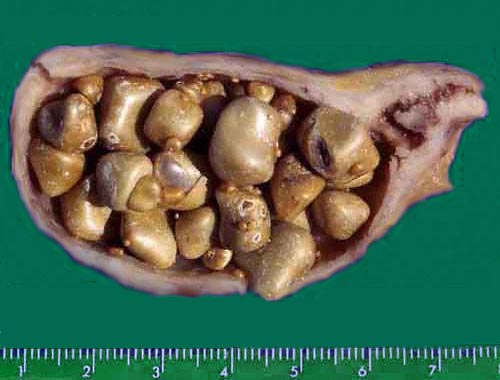Gallstones (Cholelithiasis)
Cholelithiasis is the medical term for gallstone disease. Gallstones are hard, pebble-like deposits that form inside the gallbladder. Gallstones may be as small as a grain of sand or as large as a golf ball. Gallstones are concretions that form in the biliary tract, usually in the gallbladder. Gallstones develop insidiously, and they may remain asymptomatic for decades. Migration of a a gallstone into the opening of the cystic duct may block the outflow of bile during gallbladder contraction. The resulting increase in gallbladder wall tension produces a characteristic type of pain (biliary colic). Cystic duct obstruction, if it persists for more than a few hours, may lead to acute gallbladder inflammation (acute cholecystitis). Choledocholithiasis refers to the presence of one or more gallstones in the common bile duct. Usually, this occurs when a gallstone passes from the gallbladder into the common bile duct. Gallstones are highly prevalent, but mostly asymptomatic. Symptoms occur with obstruction of the cystic or bile duct or erosion of gallstones through the gallbladder. The principle causative defects are cholesterol supersaturation, accelerated nucleation, and gallbladder hypomotility. Common risk factors include older age, female gender, obesity, rapid weight loss, drugs, and pregnancy. The definitive initial radiographic test for symptomatic patients is abdominal ultrasound. Laparoscopic cholecystectomy is the definitive treatment for symptomatic patients. Complications such as cholecystitis, cholangitis, and pancreatitis develop in 0.1% to 0.3% of patients annually and are the most common gastrointestinal disease requiring hospitalization in the US.
